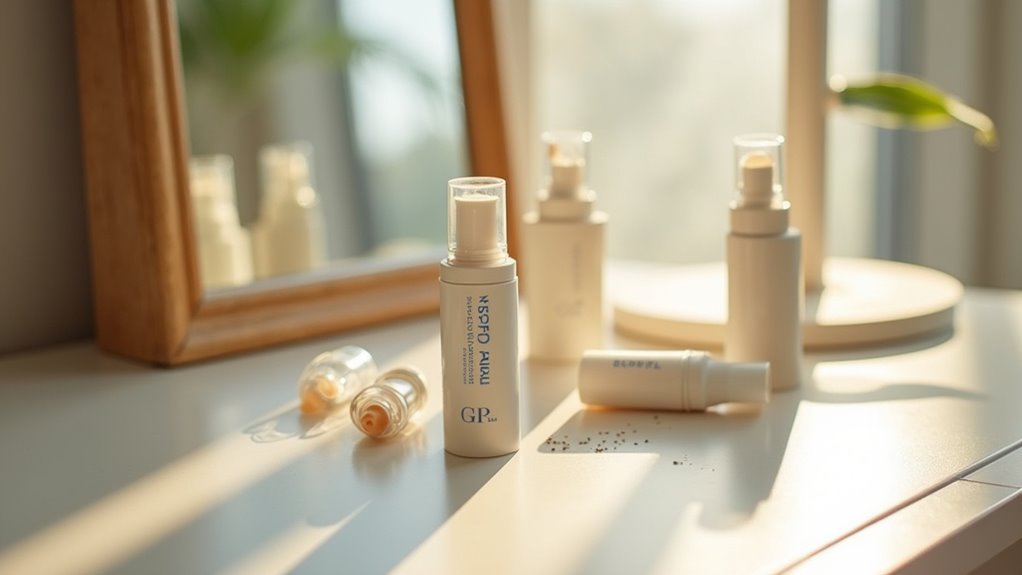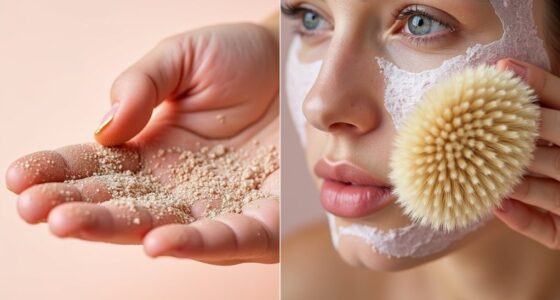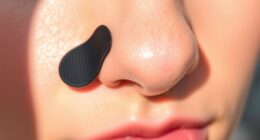You might be unknowingly undermining your sun protection by skipping sunscreen before heading out, not applying enough, or relying only on SPF during peak hours. Reapplying after sweating or water exposure is often forgotten, leaving your skin unprotected. Using expired or inappropriate formulas also reduces effectiveness. Staying aware of these hidden mistakes can make a big difference, and if you keep going, you’ll uncover even more ways to protect your skin daily.
Key Takeaways
- Forgetting to apply sunscreen before outdoor activities leaves skin exposed to harmful UV rays.
- Underapplying sunscreen results in inadequate coverage, increasing risk of sunburn and damage.
- Relying solely on SPF during peak hours ignores the need for shade and protective clothing.
- Not reapplying sunscreen after sweating or water exposure allows UV rays to penetrate unprotected skin.
- Using expired or inappropriate sunscreens reduces effectiveness, increasing daily skin burn risk.
Skipping Sunscreen Application Before Going Outdoors

Have you ever headed outside without applying sunscreen first? Skipping this step can leave your skin vulnerable to harmful UV rays. Proper application techniques are essential; you should generously cover all exposed areas, including often-missed spots like ears and the back of your neck. When choosing sunscreen ingredients, look for broad-spectrum protection with active ingredients like zinc oxide or avobenzone, which shield against UVA and UVB rays. Applying sunscreen evenly and at the right time—about 15 minutes before sun exposure—ensures maximum effectiveness. Forgetting to do this can result in unnecessary skin damage over time. Remember, skipping sunscreen isn’t just about forgetting; it’s about understanding how proper sunscreen application techniques and the right ingredients protect your skin daily. Incorporating sun protection habits into your routine can significantly reduce the risk of skin damage and long-term aging. Additionally, being aware of hidden SPF mistakes can help you avoid common errors that compromise your sun protection. Using essential oils to promote skin healing and hydration can also support your skin’s resilience against UV damage over time.
Not Applying Enough Sunscreen for Adequate Coverage
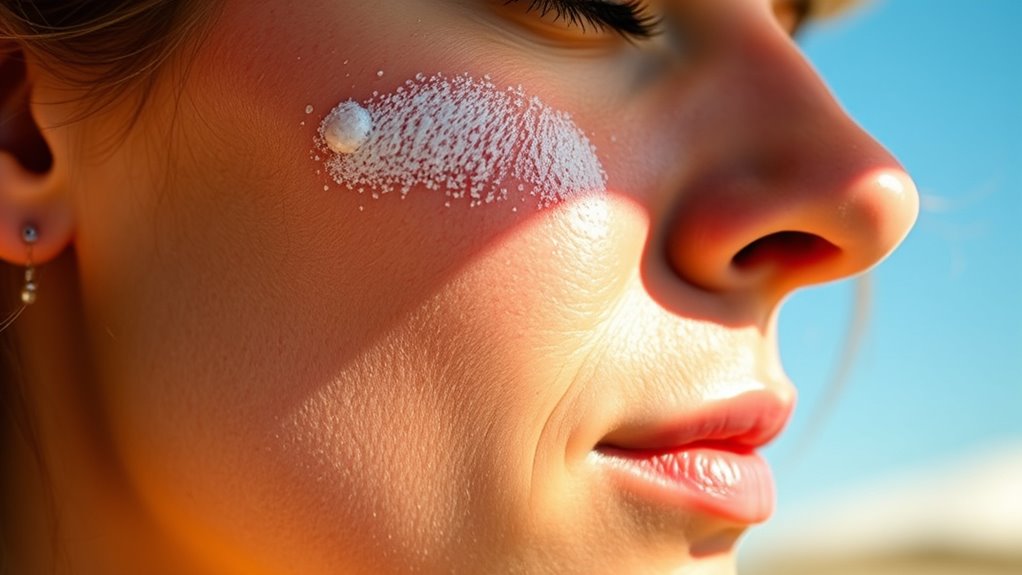
Applying too little sunscreen can leave parts of your skin unprotected, increasing your risk of sun damage. Many people underestimate how much sunscreen is needed, leading to insufficient sunscreen thickness. When you don’t apply enough, coverage consistency suffers, leaving gaps that expose your skin to harmful UV rays. To guarantee proper protection, use a generous amount—about a shot glass full for your face and body. Spread it evenly, making sure every area receives a uniform layer. Thin or uneven application creates weak spots in your defense, so take your time to cover all surfaces thoroughly. Remember, adequate coverage isn’t just about quantity; it’s about consistent application across your skin. Skimping on sunscreen leaves you vulnerable, so apply enough to create a proper, even barrier.
Relying Solely on SPF During Peak Sun Hours

Relying solely on SPF during peak sun hours can give a false sense of security, leaving your skin vulnerable even if you’ve applied sunscreen. Many fall for sun safety misconceptions, thinking SPF alone protects them. Remember, SPF application tips are essential for effective coverage. Here are four key points to consider:
- SPF doesn’t block all UV rays; it reduces exposure but isn’t foolproof.
- Applying SPF too late or unevenly can leave skin exposed.
- Peak sun hours (10 a.m. to 4 p.m.) aren’t the only risky times.
- Relying only on sunscreen neglects other protective measures like seeking shade or wearing protective clothing. Incorporating UV protection strategies can significantly enhance your skin safety.
- Developing a growth mindset about sun safety encourages proactive habits and continuous learning about protecting your skin.
Don’t assume SPF is enough—combine it with physical barriers and seek shade for thorough sun safety.
Forgetting to Reapply After Sweating or Water Exposure
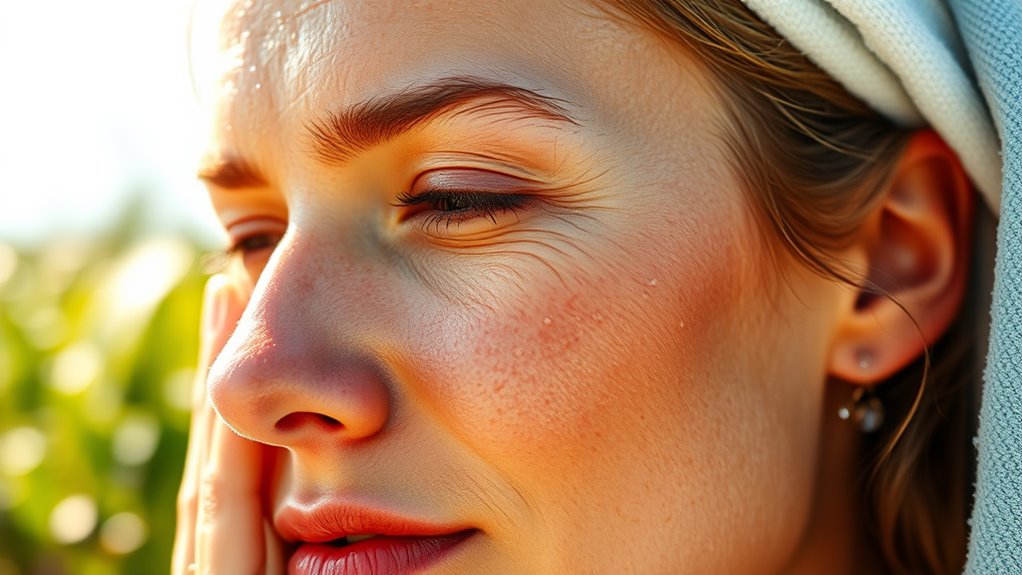
Even if you’ve applied sunscreen carefully, it’s easy to forget to reapply after sweating or swimming, which can substantially reduce its effectiveness. Water-resistant formulas help, but they aren’t foolproof—they still need reapplication according to your reapplication schedule. When you sweat heavily or get water on your skin, the protective layer can wash away or break down faster. To stay protected, plan to reapply sunscreen every two hours, or sooner if you’ve been swimming or sweating a lot. Remember, water-resistant doesn’t mean waterproof. Make it a habit to reapply promptly after water exposure or heavy sweating to maintain full protection. Skipping this step leaves your skin vulnerable to UV damage, even if you think you’re protected.
Using Expired or Inappropriate Sunscreen Formulas

Using expired or inappropriate sunscreen formulas can substantially reduce your protection against UV rays. When sunscreen sits beyond its expiration date, its active ingredients degrade, making it less effective. Improper sunscreen storage, like exposure to heat or sunlight, accelerates this breakdown. Additionally, some formulas may contain ingredients that trigger sensitivity or allergic reactions, especially if they’re past their prime. To avoid these issues, consider these points:
- Regularly check expiration dates on your sunscreen bottles.
- Store sunscreen in a cool, dark place to maintain efficacy.
- Be aware of ingredient sensitivity, especially with chemical filters.
- Replace your sunscreen at least once a year to ensure maximum protection.
- Using a properly maintained SPF and replacing it regularly ensures optimal skin protection and minimizes the risk of adverse reactions. Ensuring your sunscreen has a high-quality filter technology can further enhance its effectiveness. Sticking to fresh, properly stored formulas keeps your skin safe from harmful UV damage.
Frequently Asked Questions
Can SPF Protect Against All Types of UV Rays?
SPF mainly protects against UVB rays, which cause sunburn, but it doesn’t block all UV rays across the UV spectrum. UVA rays penetrate deeper, contributing to skin damage and aging. So, even with SPF, you’re not fully shielded from all UV rays. To best protect your skin, choose broad-spectrum sunscreens, wear protective clothing, and seek shade during peak sun hours.
Is Higher SPF Always Better for Daily Wear?
You might think higher SPF offers better protection, but that’s not always true. SPF label accuracy can vary, and higher SPF doesn’t mean you’re fully protected from UV rays. Daily wear should focus on broad-spectrum SPF 30 or higher, and remember, sun protection myths often lead people to overuse SPF. It’s more important to reapply regularly and combine with other sun safety habits than just chasing a higher SPF number.
How Do Environmental Factors Affect Sunscreen Effectiveness?
Imagine walking through a city with heavy air pollution, and your sunscreen seems less effective. Environmental factors like air pollution can break down your sunscreen, reducing its protection. This exposure accelerates skin aging and damages your skin barrier. To stay protected, reapply sunscreen more frequently and choose formulas that shield against pollutants. Environmental factors directly impact sunscreen effectiveness, so staying vigilant helps prevent premature skin aging caused by these external aggressors.
Can Makeup or Moisturizer Replace Sunscreen?
You might think makeup SPF or moisturizer SPF can replace sunscreen, but they often don’t provide enough protection on their own. While these products add a layer of defense, they usually have lower SPF ratings and may not be applied thickly enough. For full protection, you should use a dedicated broad-spectrum sunscreen underneath, then follow with makeup or moisturizer SPF for extra coverage. Don’t rely solely on makeup SPF or moisturizer SPF to protect your skin.
What Ingredients Should I Avoid in Sunscreen Formulas?
Oh, the joy of sunscreen shopping! You should avoid formulas packed with harsh chemical filters that may irritate your skin or cause allergies. Instead, look for mineral blockers like zinc oxide or titanium dioxide—they’re the gentle giants that shield you without sneaking into your bloodstream. Skip sunscreens loaded with questionable ingredients, and your face will thank you for the simple, effective protection without the unnecessary drama.
Conclusion
Are you unknowingly sabotaging your skin with these common SPF mistakes? Skipping daily sunscreen, not applying enough, or forgetting to reapply after sweating can all lead to unnecessary damage. Using expired formulas or relying only on SPF during peak hours also reduces protection. Don’t let these hidden errors burn your face daily—your skin deserves better. Isn’t it time you took full control and protected your skin like a pro?
